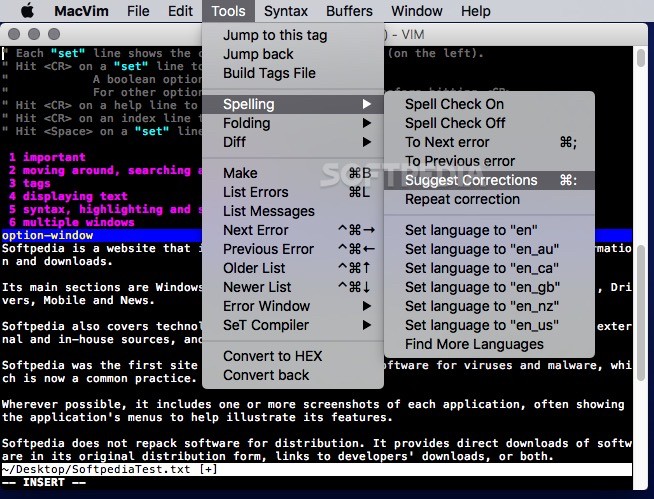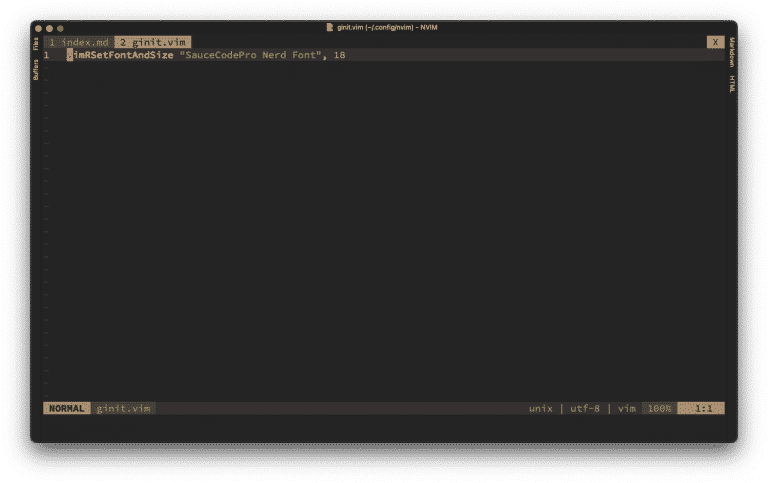

For me vim-plug offers three advantages over Vundle: (1) The automatic install script (shown above) is nice for portability, (2) When using Neovim, vim-plug updates the plugins asynchronously, and (3) you don’t have to turn off file type detection ( filetype off) in your vimrc when you list your plugins with vim-plug, as you do with Vundle.
#Macvim vs neovim upgrade
I can run :PlugUpdate to get the latest versions of all the plugins, or :PlugUpgrade to upgrade vim-plug itself. Plug 'tpope/vim-fugitive' " All of your Plugins must be added before the following line call plug#end ()Īnd I’m good to go. Plug 'kana/vim-textobj-line' | Plug 'kana/vim-textobj-user' Plug 'kana/vim-textobj-indent' | Plug 'kana/vim-textobj-user' Plug 'jceb/vim-textobj-uri' | Plug 'kana/vim-textobj-user' Plug 'lucapette/vim-textobj-underscore' | Plug 'kana/vim-textobj-user' In fact the first few lines of my vimrc automatically installs vim-plug if it’s not detected then installs all the listed plugins, a trick I picked up from vim-plug’s FAQ: To manage my ever-changing list of vim plugins I use vim-plug, which works really well. (I haven’t found a good Neovim GUI yet, though there are some other there, including Neovim dot app.) My Plugin Manager

Neovim + iTerm2 is a pretty great combo, but for somethings I like using a GUI (MacVim). Just note that, throughout this post I’ll likely keep referring to my Vim config file as “my vimrc”. (Just to be clear, most settings work in both regualr Vim and Neovim.) If you choose this route, obviously your config file is no longer called vimrc but rather init.vim. Or you can maintain a separate Vim config file for Neovim by simply putting your config code into ~/.config/nvim/init.vim. See ':help nvim' for more information on Neovim. One way to make using both easier is to use your existing configuration by making these two symlinks: I’ll also admit that part of the reason I do this is because the iTerm2 + Neovim combo isn’t super stable at this point, as I’m running a beta version of iTerm2 in order to get better/more colors for Neovim. Sometimes I want to stay in the terminal (in which case I fire up Neovim), and other times I want a separate GUI. Neovimīasically I split my usage between Neovim and MacVim. You can see my relatively up-to-date vimrc here.
#Macvim vs neovim update
But rather than update it with each new plugin and mapping, I’m going to leave this post as is, as the setup is still pretty solid.

Note from May 2017: My vimrc has changed a bit since I wrote this post, which I wrote in February of 2016. But there’s plenty of more, smaller tricks I’ve picked up since then. I’ve already written about a Markdown hyperlink remap that still works really well and how I ditched NERDTree in favor of netrw. I’m certainly no Vim expert, but if nothing else than recording my “progress,” here’s a bit about how I use Vim at this point. I just realized that I’ve been using Vim for just about a year now (here’s one of my early posts on starting to make the switch), so I figured it’d be a good time to go over some of favorite parts of my vimrc.


 0 kommentar(er)
0 kommentar(er)
